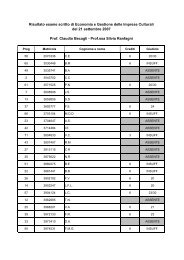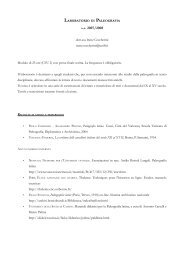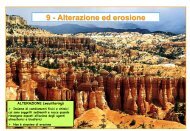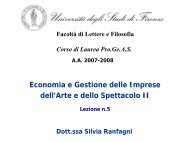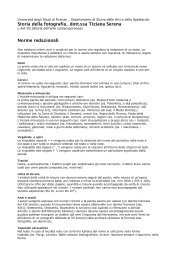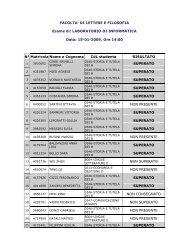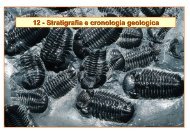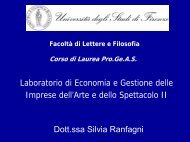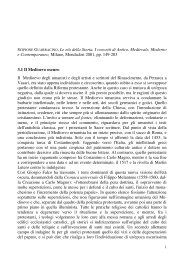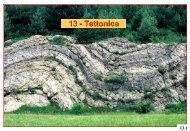Beyond Pragmatics. Morphosyntactic Development in Autism.pdf
Beyond Pragmatics. Morphosyntactic Development in Autism.pdf
Beyond Pragmatics. Morphosyntactic Development in Autism.pdf
You also want an ePaper? Increase the reach of your titles
YUMPU automatically turns print PDFs into web optimized ePapers that Google loves.
J <strong>Autism</strong> Dev Disord<br />
exam<strong>in</strong>ed the frequency of grammatical errors and the<br />
types of errors produced. Because the focus was not on<br />
exhaustively identify<strong>in</strong>g every possible error, but<br />
rather on establish<strong>in</strong>g possible l<strong>in</strong>ks between error<br />
rates and syntactic deficits, <strong>in</strong>clusion criteria were<br />
strict. Thus, transcripts were exam<strong>in</strong>ed, utterance by<br />
utterance, and only clear, unambiguous errors of<br />
omission and errors of commission (Bates, 1997) were<br />
<strong>in</strong>cluded. Results and examples are presented <strong>in</strong><br />
Table 4.<br />
F<strong>in</strong>d<strong>in</strong>gs <strong>in</strong>dicated that the DD group exhibited<br />
significantly more errors of omission than both the<br />
ASD and TD groups (p’s = .06 and .003, respectively),<br />
whereas there were no differences <strong>in</strong> errors of commission<br />
(all p’s > .5). To summarize, children <strong>in</strong> the<br />
DD group were more likely to omit required grammatical<br />
structures than children <strong>in</strong> the autism and TD<br />
groups.<br />
Nonsense Words (jargon)<br />
Play session transcripts were analyzed for the presence<br />
of jargon, def<strong>in</strong>ed as <strong>in</strong>telligible but un<strong>in</strong>terpretable<br />
words or phrases. Any words or phrases that the<br />
transcriber was able to hear, but was not able to<br />
supply a gloss or mean<strong>in</strong>g for, were <strong>in</strong>cluded, such as,<br />
‘‘the serpice [sic] is fly<strong>in</strong>g.’’ This def<strong>in</strong>ition was designed<br />
to dist<strong>in</strong>guish utterances <strong>in</strong> which a child mispronounces<br />
an item (as <strong>in</strong>, ‘‘go<strong>in</strong>’ to make a lelivery,’’<br />
when context and previous utterances <strong>in</strong>dicate that the<br />
child’s target was ‘delivery’), from utterances where<br />
the child seems to be produc<strong>in</strong>g a novel wordform. 4<br />
Results <strong>in</strong>dicated that the <strong>in</strong>cidence of jargon was as<br />
follows: <strong>Autism</strong> group, Mean (SD) = 4.9 (5.3),<br />
range = 0–17; DD group, Mean (SD) = 1.3 (1.6),<br />
range = 0–5; TD group, Mean (SD) = .3 (.6),<br />
range = 0–2. Groups differed significantly, F(2,<br />
45) = 9.005, p < .001, and post hocs <strong>in</strong>dicated that<br />
children with autism produced more jargon than<br />
children <strong>in</strong> the DD group, p < .009, and TD group,<br />
p < .001.<br />
Topic Analysis<br />
4 In this scheme, some utterances are likely to be erroneously<br />
labeled as jargon, when the experimenter fails to recognize a<br />
target utterance even though it is a known word. Utterances<br />
from children with poor articulation will be over-<strong>in</strong>cluded,<br />
mak<strong>in</strong>g comparisons between the autism and DD group more<br />
conservative, as the latter are likely to have misarticulations.<br />
One challenge for the present f<strong>in</strong>d<strong>in</strong>gs is that children<br />
<strong>in</strong> the autism group may have produced less complex<br />
grammatical structures because the topics they discussed<br />
were less complex. For example, to describe<br />
people or events that are not present, specific grammatical<br />
structures (e.g., subjunctive or past tense) are<br />
required. Talk about non-present events or people will<br />
entail relatively more complex structures, and differences<br />
<strong>in</strong> such talk may be ascribed to conceptual referential<br />
grounds rather than morphosyntactic<br />
knowledge. Thus, syntactic delays <strong>in</strong> autism may reflect<br />
conceptual rather than grammatical delays. In general,<br />
evidence from typical development <strong>in</strong>dicates that<br />
children are more likely to use here-and-now (vs.<br />
displacement) language than are adults (Wanska &<br />
Bedrosian, 1986).<br />
The transcripts were exam<strong>in</strong>ed for references to<br />
items, events, or people not physically or temporally<br />
present (Foster, 1986). This referential doma<strong>in</strong> was<br />
chosen because children at this developmental stage<br />
were likely to be able have this conceptual ability.<br />
Specifically, transcripts were assessed, utterance by<br />
utterance, for the presence of an antecedent which was<br />
identifiable as physically present. For example, <strong>in</strong> this<br />
dialogue, a child is pull<strong>in</strong>g toys from a toybox and<br />
remark<strong>in</strong>g on them to the experimenter (EXPTR). All<br />
references were to the here-and-now:<br />
CHILD: what’s dis [: this]<br />
EXPTR: I don’t know, what do you th<strong>in</strong>k<br />
CHILD: a dum(p) t(r)uck.<br />
EXPTR: yeah!<br />
CHILD: a big dump tuck [e.g., truck] wif [e.g., with]<br />
that big t<strong>in</strong>g [th<strong>in</strong>g].<br />
CHILD: got big th<strong>in</strong>gs on it.<br />
In contrast, <strong>in</strong> the follow<strong>in</strong>g dialogue, the child (age<br />
three) refers to two events that may transpire <strong>in</strong> future<br />
(turn<strong>in</strong>g five years old, and rid<strong>in</strong>g a bus):<br />
CHILD: I’m gonna be five like Sally, too!<br />
EXPTR: five<br />
CHILD: yeah. Sally ‘s five more. She’s, she’s still five.<br />
EXPTR: yeah well it’s fun to be little sometimes, too,<br />
dontcha th<strong>in</strong>k<br />
CHILD: [chuckl<strong>in</strong>g].<br />
EXPTR: so what other th<strong>in</strong>gs are you gonna do when<br />
you’re five<br />
CHILD: um, I’m gonna go on the bus.<br />
EXPTR: on the bus wow.<br />
CHILD: that’s when I’m five<br />
While this rather coarse conflation of many syntactic<br />
categories and types of utterances obscures f<strong>in</strong>er issues<br />
about the development of these categories, and may <strong>in</strong> fact<br />
not reflect accurately the complexity demanded by<br />
123


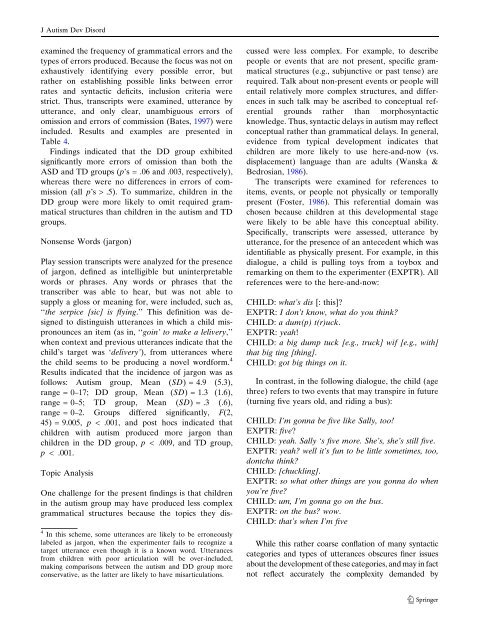
![PATROLOGIA GRECA E LATINA [Patrologiae cursus completus]. All ...](https://img.yumpu.com/50711133/1/184x260/patrologia-greca-e-latina-patrologiae-cursus-completus-all-.jpg?quality=85)
